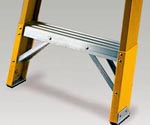The OSHA Standard for portable ladders contains specific requirements designed to ensure worker safety:
Loads
- Self-supporting (foldout) and non-self-supporting (leaning) portable ladders must be able to support at least four times the maximum intended load, except extra-heavy-duty metal or plastic ladders, which must be able to sustain 3.3 times the maximum intended load.
Angle
- Non-self-supporting ladders, which must lean against a wall or other support, are to be positioned at such an angle that the horizontal distance from the top support to the foot of the ladder is about 1⁄4 the working length of the ladder.
- In the case of job-made wooden ladders, that angle should equal about 1⁄8 the working length. This minimizes the strain of the load on ladder joints that may not be as strong as on commercially manufactured ladders.
Rungs
- Ladder rungs, cleats, or steps must be parallel, level, and uniformly spaced when the ladder is in position for use. Rungs must be spaced between 10″-14″ inches apart.
- For extension trestle ladders, the spacing must be 8″-18″ inches for the base, and 6″-12″ inches on the extension section.
- Rungs must be so shaped that an employee’s foot cannot slide off, and must be skid-resistant.
Slipping
- Ladders are to be kept free of oil, grease, wet paint, and other slipping hazards.
- Wood ladders must not be coated with any opaque covering, except identification or warning labels on one face only of a side rail.
Other Requirements
- Foldout or stepladders must have a metal spreader or locking device to hold the front and back sections in an open position when in use.
- When two or more ladders are used to reach a work area, they must be offset with a landing or platform between the ladders.
- The area around the top and bottom of ladder must be kept clear.
- Ladders must not be tied or fastened together to provide longer sections, unless they are specifically designed for such use.
- Never use a ladder for any purpose other than the one for which it was designed.
